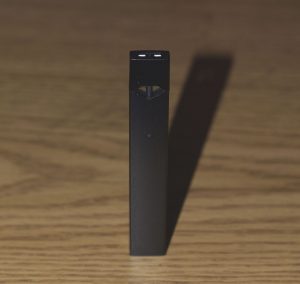 Reading Time: 4 minutes
Reading Time: 4 minutesIf you follow the news around tobacco harm reduction you’ll know that pod mods – especially the JUUL – are the subject of the USA’s latest moral panic. The country that gave us Prohibition and the war on drugs (the reason the USA has more people in jail than China, a communist dictatorship with four times the population) is whipping itself into a froth of righteous indignation about a product that was specifically designed as a safer alternative for smokers.
What’s got so many people’s knickers in a twist is the idea that teenagers are going to be attracted to JUUL because it looks like a skinnier version of a ten-year-old USB memory stick – remember when they were long and thin? – then, for mysterious reasons, suddenly decide they’d much rather spend their money on something that doesn’t taste as good, makes clothes and hair smell of stale smoke, costs more and has a 50% chance of killing them. Of course, the problem with the so-called “gateway” from vaping to smoking is that, according to all the evidence, it doesn’t exist. So if you’re from the USA and work in public health, that leaves you with a bit of a problem.
It’s increasingly unconvincing to claim that pod mods are bad because they lead to smoking, but who wants to admit that something people enjoy is actually pretty harmless? Luckily, there’s a simple solution – claim that pod mods are bad because they just are, okay? Tell the public that JUUL is just as bad for you as an actual cigarette and you can keep on preaching at them as long as you like.
Facts are awkward
There’s just one problem, of course. A ton of evidence says that JUUL – and all other e-cigs, and Heat not Burn devices like iQOS – are orders of magnitude less dangerous than actual lit tobacco. It doesn’t matter how often clowns like Stan Glantz wail “We don’t know what’s in them!!” The fact is we do know what’s in them. I can’t honestly think of any other product that’s been so intensely studied in such a short space of time.
E-liquid and the vapour it produces have been through every scientific test you can imagine. I’ve even had some of my own home-made liquid analysed as part of a research project, and the researcher was able to tell me how much nicotine was in it down to a fraction of a percent. Working out what’s in a small bottle of liquid is something modern science is actually really, really good at, and anti-vaping nutters like Glantz know this.
Anyway, JUUL Labs seem to have got fed up with people saying we don’t know what’s in the vapour from their products, so a few days ago they sent me details of a clinical study of their devices and another pod mod. Let’s look at what they found.
The study looked at a group of former smokers who now use JUUL or Vuse Solo e-cigs, compared with a group of smokers and a control group who used dummy devices – in other words, they weren’t actually inhaling anything. Exhaled breath from the users – “secondhand vapour” – was collected and analysed, and the air in the room was also tested. Three chemicals were tested for:
- Carbon monoxide. Never mind tar; this is the most dangerous chemical in cigarette smoke. Caused by incomplete combustion, it blocks red blood cells from carrying oxygen. In lower doses it stresses the heart and contributes to arterial stiffness; in high doses it can kill in minutes. The researchers measured exhaled breath for its carbon monoxide content.
- Formaldehyde. Classed as a human carcinogen (although nobody seems very sure which cancers it actually causes), formaldehyde has been a hobby horse of anti-vapers for years. If you run an e-cig atomiser dry, or fit a small CE4-style clearomiser to a high-powered mod, it’s possible to overheat the liquid so much that PG breaks down and releases formaldehyde. However, this tastes so vile that no vaper ever does it twice. Anyway, public health people worry about it, so exhaled breath was also tested for formaldehyde.
- Nicotine. Nicotine does not cause cancer or heart disease, and doesn’t even seem to be very addictive unless inhaled in tobacco smoke, but anti-vapers absolutely hate the stuff. Air in the rooms where the test subjects vaped or smoked was tested for nicotine.
Much ado about nothing
So, what happened? Well, if you’ve been worrying about what’s in the vapour from your pod mod you can stop now. The results showed that – surprise! – vaping eliminates almost all the harmful chemicals found in cigarette smoke.
To be precise, levels of both carbon monoxide and formaldehyde in exhaled vapour are only 1% of what a smoker exhales. In fact there was no significant difference between vapers and people who neither smoke nor vape.
This shouldn’t be a surprise. Carbon monoxide is a combustion product, and e-cigs don’t burn anything. Formaldehyde is only produced in extreme conditions, and those can’t happen with a modern pod mod. So, at least as far as these two chemicals are concerned, the health risk from vaping a JUUL is basically zero.
When it came to nicotine there was a bit more of that floating around – but still not much. Nicotine levels where test participants had been vaping were from 89% to 95% lower than where they had been smoking. This is a good place to point out that when people talk about the dangers of second-hand smoke they never mention nicotine as a problem, because it isn’t. Why should the much lower levels of nicotine in second-hand vapour be any concern? The blunt truth is, inhaling low levels of nicotine will do you no harm at all. Spending all day in a room with ten vapers will expose you to less nicotine than eating a single tomato.
Pod mods are fairly new, but they work in the same way as any other e-cig – and vaping has been around for years now. It’s ridiculous that researchers are still having to waste time and money proving what we already know, but that’s the world we live in. As long as people say “We don’t know what’s in those things” we’ll need more research to prove that yes we do, and it isn’t doing any harm. That’s what this study shows. Want more details? You can read the whole thing here.












